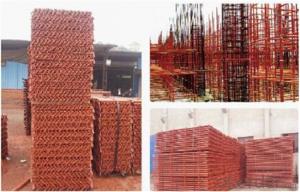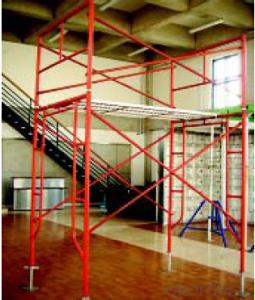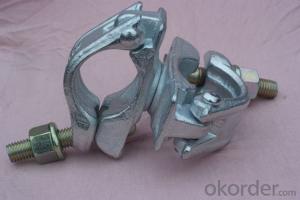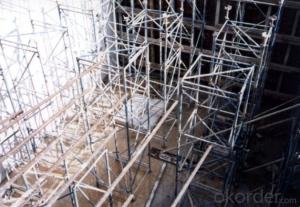Steel Pipe Fixed Scaffolding Clamp british German Forged Type
- Loading Port:
- Tianjin
- Payment Terms:
- TT OR LC
- Min Order Qty:
- 1000 kg
- Supply Capability:
- 100000 kg/month
OKorder Service Pledge
OKorder Financial Service
You Might Also Like
Steel Pipe Fixed Scaffolding Clamp british German Forged Type
Description
1.The scaffolding coupler is always used to connect the steel pipe as scaffolding system.
2.The often used coupler is swivel coupler and righ angle coupler .
3.We can provide types of scaffolding coupler according to your requirement.
4.Couoler can fix the 48.3mm scaffolding steel pipe tightly and make the whole scaffolding system more steadily.
Feature
(1)Excellent Anti-Breaking—Cold Pressed Steel
(2)Outstanding Resistance Deformation
(3)Strong Anti-Dropping Ability
Photo
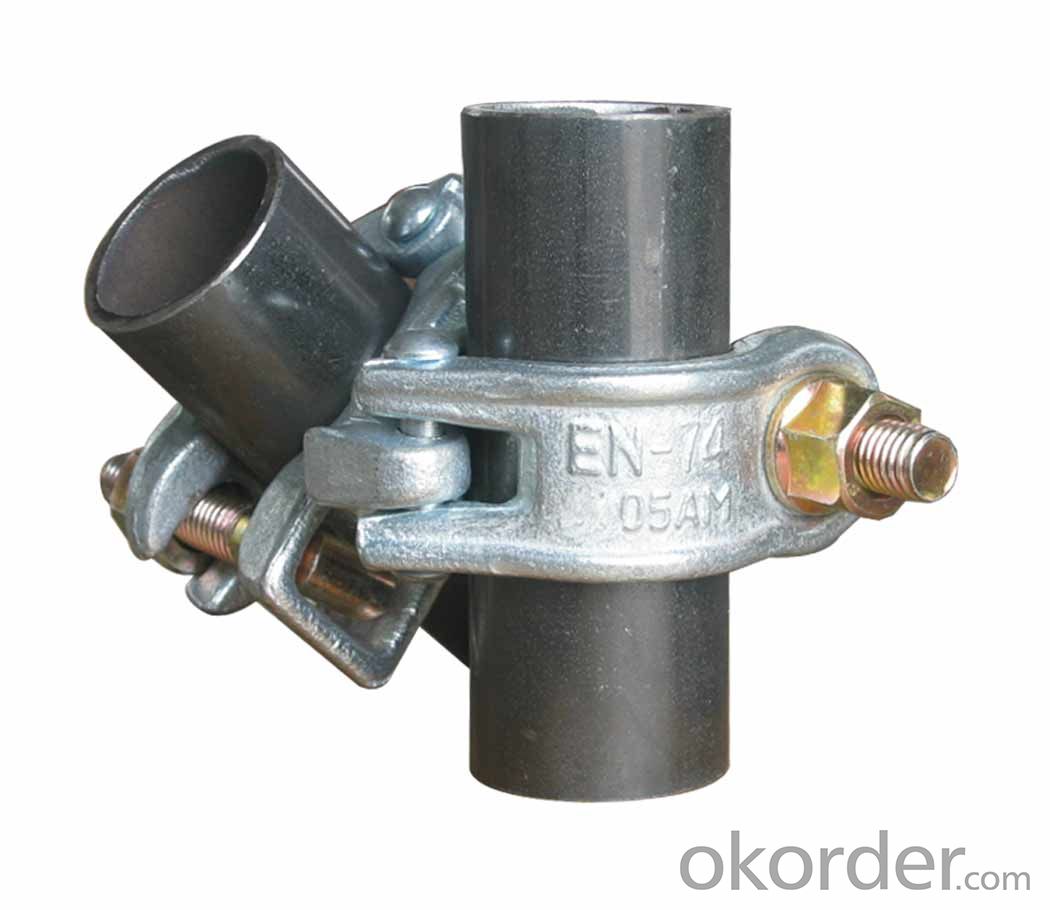
Parameter
| Material | Q235,345steel |
| Size | 48.3mm*48.3mm |
| Surface finish | Galvanized |
| Weight | 1.1kg around |
| Standard | BS1139,EN74 |
| Package | 25pcs/bag,steel pallet |
| Manufacture | As per customer requirement |
| Market | Africa, South America, the Middle East and Asia |
FAQ
Q: Are you a factory or trading company?
We are a state-owned corporation in China,dealing with various kinds of building materials.We have our holding subsidiaries.
Q: Where is your factory located? How can I visit there?
Our factory is located all around China.
Q: Can I get some samples?
Sample is free, customer only pay freight for the first time.
Q: Delivery?
10-30days. (5-15 containers)
Any question,feel free to contact us.
- Q: What are steel tube couplers and how are they used in scaffolding?
- Scaffolding relies on steel tube couplers to securely join steel tubes together. These couplers, typically crafted from high-quality steel, come in various types such as sleeve, swivel, putlog, and girder couplers. The main purpose of steel tube couplers in scaffolding is to establish a strong and dependable connection between two tubes. This connection ensures the scaffold structure's stability and safety by withstanding heavy loads and preventing any movement or separation between the tubes. Steel tube couplers are utilized in scaffolding construction to create different configurations and connections. Sleeve couplers are commonly used to connect two tubes end-to-end, forming longer vertical or horizontal members. Conversely, swivel couplers enable angled connections, making it possible to set up scaffolding on uneven or sloping surfaces. Putlog couplers are employed to attach scaffold boards or planks to the main scaffold structure, providing a stable platform for workers. Girder couplers are specially designed to connect steel beams or girders to the scaffold, allowing for the construction of more extensive and intricate scaffolding systems. In summary, steel tube couplers play a vital role in the construction industry, ensuring a secure and long-lasting connection between steel tubes in scaffolding. They guarantee the strength and stability of the scaffold structure, enabling workers to safely access and perform tasks at elevated heights.
- Q: What are the safety regulations and standards for steel tube couplers in scaffolding?
- The safety regulations and standards for steel tube couplers in scaffolding typically include requirements for load capacity, material quality, design specifications, and manufacturing processes. These regulations ensure that the couplers are able to withstand the intended loads and prevent accidents or failures. Additionally, they may also cover aspects such as proper installation procedures, regular inspections, and maintenance practices to ensure ongoing safety. Compliance with these regulations and standards is crucial to ensure the integrity and stability of scaffolding structures.
- Q: Construction of fastener type steel pipe scaffolding safety technical specifications JGJ130-2011 on the steel cantilevered scaffolding provisions
- XPS board easy brittle, high prices, EPS flexible flexibility, the price is relatively cheap
- Q: Can steel tube couplers be used for scaffolding structures that need to provide access to elevated or sloping areas?
- Yes, steel tube couplers can be used for scaffolding structures that need to provide access to elevated or sloping areas. Steel tube couplers are versatile and can be used to create secure connections between scaffolding tubes, allowing for the construction of stable and reliable scaffolding structures. These structures can be designed to accommodate different terrains, including elevated or sloping areas, ensuring safe access to various heights and angles.
- Q: What are the common inspection procedures for steel tube couplers?
- The common inspection procedures for steel tube couplers typically involve visual examination for any visible defects such as cracks, surface irregularities, or corrosion. Additionally, dimensional measurements are taken to ensure the couplers meet the required specifications. Non-destructive testing methods, such as ultrasonic or magnetic particle testing, may also be employed to detect any internal flaws or defects that are not visible to the naked eye. The couplers are further inspected for proper thread engagement and tightness to ensure their functionality and reliability.
- Q: What are the common inspection procedures for steel tube couplers?
- The common inspection procedures for steel tube couplers typically involve visual inspection, dimensional measurement, and material testing. Visual inspection is the first step in the inspection process, where the couplers are visually examined for any surface defects such as cracks, burrs, or any other irregularities that could affect their performance. This inspection is essential to ensure that the couplers are in good condition and free from any visible damage. Dimensional measurement is crucial to verify the accuracy of the couplers' dimensions. It involves using various measuring tools like calipers, micrometers, or gauges to check the inner and outer diameters, length, and other critical dimensions specified in the design or industry standards. This inspection ensures that the couplers meet the required specifications and can be properly fitted with the steel tubes. Material testing is another important inspection procedure for steel tube couplers. It involves conducting various tests, such as tensile strength testing, hardness testing, and chemical composition analysis, to ensure that the couplers are made from the correct grade of steel and possess the necessary mechanical properties. These tests help determine the couplers' durability, load-bearing capacity, and resistance to corrosion or other forms of degradation. In addition to these common inspection procedures, other tests or examinations may also be performed based on specific requirements or industry standards. These may include non-destructive testing methods like ultrasonic testing or radiographic examination to detect any hidden defects or internal flaws in the couplers. Overall, the common inspection procedures for steel tube couplers aim to ensure that they are of high quality, meet the required specifications, and are safe and reliable for their intended applications.
- Q: How are steel tube couplers used in scaffolding?
- In the realm of scaffolding, steel tube couplers are widely utilized to unite two or more steel tubes. Their primary function is to establish inflexible connections between tubes, thereby facilitating the construction of a dependable and well-protected scaffold structure. An assortment of steel tube couplers is available, which includes swivel couplers, putlog couplers, sleeve couplers, and girder couplers. Each type has been specifically engineered to serve a unique purpose in scaffolding construction. Swivel couplers reign supreme as the most frequently employed type of coupler in the field of scaffolding. They possess the remarkable ability to rotate a full 360 degrees, enabling tubes to be interconnected at any conceivable angle. This inherent flexibility proves invaluable when erecting scaffolding on uneven or irregular surfaces. Putlog couplers, on the other hand, are employed to join transoms or putlogs to ledgers or tubes. They facilitate the secure fastening of wooden boards or steel planks, thereby establishing a functional platform within the scaffold structure. Sleeve couplers are implemented to connect two tubes end-to-end, effectively extending their length. This proves particularly advantageous when longer tubes are necessitated for vertical or diagonal bracing. Girder couplers have been specially crafted to link scaffold tubes to steel girders or beams. They forge a robust and steadfast connection between the scaffold and the supporting structure. All in all, steel tube couplers occupy an indispensable position in the realm of scaffolding, as they furnish the essential connections required for the construction of a secure and stable structure. They guarantee that the scaffold remains rigid and capable of withstanding the weight of workers, tools, and materials. When properly installed and utilized, steel tube couplers contribute significantly to the overall safety and efficiency of scaffolding operations.
- Q: What does instructional scaffolding mean?
- possibly laying a base of facts to learn before you teach more advanced material, like learning to read before learning to spell.
- Q: How do steel tube couplers perform in areas with high levels of electromagnetic fields?
- Areas with high levels of electromagnetic fields can benefit greatly from the use of steel tube couplers. These couplers have proven to be effective in shielding against electromagnetic interference (EMI) due to the properties of steel as a material. Steel is known for its high conductivity, allowing it to efficiently divert and absorb electromagnetic waves. By doing so, steel tube couplers prevent these waves from interfering with the performance of the couplers. In regions where electromagnetic fields are prominent, such as near power lines or electrical equipment, steel tube couplers act as a formidable barrier. They effectively block electromagnetic waves from penetrating through and causing interference. This shielding effect ensures that the couplers maintain their integrity and reliability, even in challenging electromagnetic environments. Steel tube couplers are widely used across industries such as telecommunications, power transmission, and construction. These industries often encounter high levels of electromagnetic fields, making the use of steel tube couplers essential. These couplers are specifically designed and manufactured to withstand the demanding conditions of these environments. Overall, steel tube couplers are a dependable choice for areas with high levels of electromagnetic fields. Their excellent shielding properties and ability to maintain optimal performance in challenging electromagnetic environments make them a reliable solution for various industries.
- Q: Are steel tube couplers compatible with scaffolding projects involving cantilevers?
- Indeed, scaffolding projects involving cantilevers can make use of steel tube couplers. The utilization of steel tube couplers is widespread within scaffolding systems due to their ability to establish a robust and secure connection between the tubes. These couplers are specifically designed to withstand the weight and forces exerted on the scaffolding structure, thus making them suitable for cantilever applications as well. Cantilever scaffolding, which allows workers to access hard-to-reach areas by extending the scaffold platform beyond the vertical supports, can benefit greatly from the use of steel tube couplers. These couplers play a crucial role in ensuring the stability and safety of the cantilever structure by firmly connecting the tubes and preventing any detachment or slippage. When undertaking a cantilever scaffolding project, it is of utmost importance to employ compatible and appropriately rated steel tube couplers. This is essential for maintaining the structural integrity of the scaffold. Adhering strictly to the instructions provided by the manufacturer and adhering to industry regulations is essential to guarantee the safety of workers and the stability of the scaffolding system. In conclusion, steel tube couplers are indeed compatible with scaffolding projects involving cantilevers. They offer a reliable connection between the tubes, thereby ensuring the stability and safety of the scaffold structure. However, it is crucial to follow the instructions provided by the manufacturer and adhere to industry guidelines to ensure proper usage and compatibility.
Send your message to us
Steel Pipe Fixed Scaffolding Clamp british German Forged Type
- Loading Port:
- Tianjin
- Payment Terms:
- TT OR LC
- Min Order Qty:
- 1000 kg
- Supply Capability:
- 100000 kg/month
OKorder Service Pledge
OKorder Financial Service
Similar products
Hot products
Hot Searches
Related keywords





